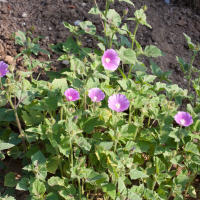Anoda weed
Anoda cristata
Anoda cristata, commonly known as crested anoda or spurred anoda, is an annual herbaceous plant that belongs to the Malvaceae family. Native to the Americas, it is found in various regions, and its natural habitat includes fields, roadsides, and disturbed areas. Here are key features and information about Anoda cristata:
-
Habitat and Distribution:
- Native Range: Crested anoda is native to the Americas, with its range extending from the United States to South America.
- Habitat: It is commonly found in disturbed areas, fields, roadsides, and open spaces.
-
Growth Characteristics:
- Annual Plant: Anoda cristata is an annual plant, completing its life cycle within one growing season.
- Herbaceous: It is herbaceous in nature, meaning it lacks persistent woody stems.
-
Appearance:
- Stems and Leaves: The plant features branched stems and palmately lobed leaves. The leaves are green, and the plant has a relatively bushy growth habit.
- Flowers: The flowers are the characteristic feature of crested anoda, with showy, saucer-shaped blooms. The flowers can range in color from pink to lavender, and they have a distinctive "spurred" or crested appearance.
-
Ecological Role:
- Wildlife Interaction: The flowers attract pollinators, including bees and butterflies, contributing to local biodiversity.
- Soil Stabilization: Like many plants in disturbed areas, Anoda cristata may play a role in stabilizing soil.
-
Invasive Potential:
- Aggressive Growth: In some regions, crested anoda can exhibit aggressive growth and may become weedy, competing with native vegetation.
-
Seed Production:
- Abundant Seeds: The plant produces numerous seeds, contributing to its ability to establish and spread in suitable habitats.
-
Conservation Considerations:
- Invasive Potential: In areas where Anoda cristata is not native, it may be considered invasive, and management strategies may be necessary to control its spread.
Understanding the growth habits, ecological interactions, and potential invasiveness of Anoda cristata is important for land management and conservation efforts. In regions where it is native, it may serve as a component of the natural ecosystem, while in non-native areas, caution is needed to prevent potential ecological disruptions.












Plant Protection Products
- ⭑⭑⭑
- ⭑⭑⭑
- ⭑⭑⭑
- N/A
- N/A
- ⭑⭑⭑
- ⭑⭑
- N/A
- N/A
- ⭑⭑⭑
- N/A
- ⭑⭑⭑
- N/A
- N/A
- N/A
- N/A
- N/A
- N/A
- N/A
- N/A
- N/A
- N/A
- N/A
- N/A
- N/A
- N/A
- N/A
- N/A
- N/A
- N/A
- N/A
- N/A
- N/A
- N/A